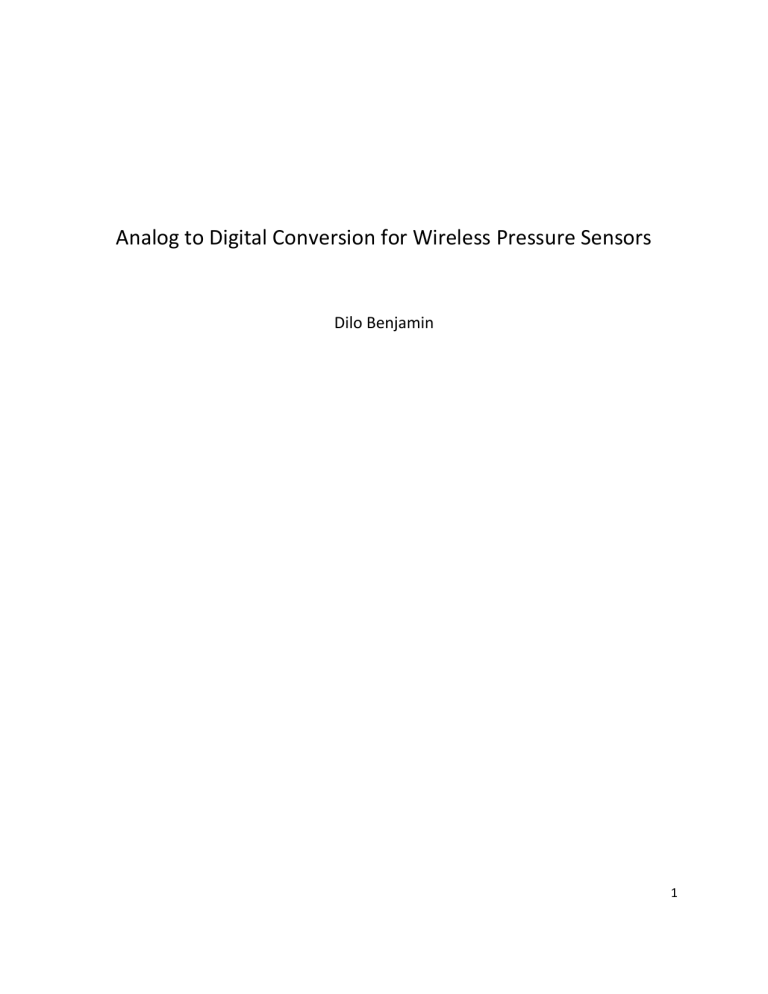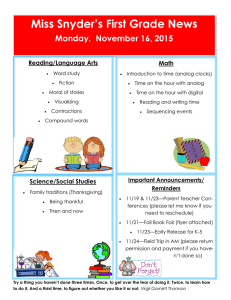Dilo

Analog to Digital Conversion for Wireless Pressure Sensors
Dilo Benjamin
1
Summary
There are many applications for pressure sensors. They are used for various tasks such as from monitoring the pressure in an oil pipe line to measuring the air pressure. The issue, however, is that most pressure sensors use a wired method with an external power supply to power the device. Usually, there is a variable current signal from 4 to 20 mA that corresponds to a particular pressure range. In some applications, such as when there are no wires to transmit the pressure data, the information needs to be wirelessly transmitted. Before it can be wirelessly transmitted, it needs to be converted from an analog signal to a digital signal.
This is done using a mixed-signal microcontroller. The information is transmitted wirelessly using ZigBee specification.
Keywords
ZigBee, wireless, microcontroller, pressure sensor, transmission, current signal, analog to digital
2
Table of Contents
1. Objective ……………………………………………………… Page 4
2. Introduction …………………………………………………. Page 4
3. Application …………………………………………………... Page 5
4. Sources of Error ……………………………………………. Page 7
7. Conclusion ………………………………………………….... Page 9
8. References ……………………………………………………. Page 10
3
Objective
The purpose of this application note is to provide information regarding analog to digital conversion and wireless transmission in wireless pressure transducers.
There are many applications in industry that require wireless pressure transducers; therefore, this application note will provide in depth information so that modifications may be made to suit individual objectives.
Introduction
Pressure transducers use an analog signal, such as 4 to 20 mA current signal, that corresponds to a specific pressure value. Before the signal can be transmitted wirelessly, it must be converted to a digital bit word. This is done to reduce signal noise, improve signal fidelity and to increase security. A mixed-signal microcontroller with an integrated analog to digital converter is used. Once that is accomplished, it is passed onto the wireless subsection of the device. Since the tolerances for pressure sensors can be very narrow, the device must convert the values to a high level of accuracy. Higher resolution leads to smaller discrete steps; thus, the accuracy of the conversion increases.
4
Application
A mixed-signal microcontroller is a device that contains both analog and digital peripherals on a single IC. Most mixed-signal chips perform a whole function on a large system such as controls in entertainment system or the radio subsection in a cell phone. In this application, it is used to convert analog signal into digital bit words. This application note will focus on the MSC1210Yx, which is an integrated family of mixed-signal devices such as high-resolution delta-sigma ADC, 8-channel multiplexer, offset DAC, PGA, temperature sensor, voltage reference, 8-bit microcontroller and memory. The device accepts differential or single ended signals from the pressure transducer. The ADC provides 24 bits of resolution for the signal bit word. It uses a Sinc 3 filter with a programmable sample rate.
5
The resolution of the converter indicates the number of discrete values representative of the analog signal. The ADC in this particular MCU has 24 bits of resolution; therefore, the each discrete step can be calculate using this formula:
Q is resolution in volts per step
E
FSR
is the voltage range
M is the ADC's resolution bits
N is the number of intervals, which is: N = 2 M − 1
6
Assuming that the transducer uses a precision 100 ohm resistor to convert the signal from current to voltage, 20 mA corresponds to (100)(.020) = 2 volts and 4 mA corresponds to (.004)(100) = .4 V. Using the formula above, (2-.4)/[(2^24)-1]
= 9.54 * 10 -8 V or 95.4 nV.
Sources of Error
The ADC is not without sources of error. Since the values are quantized, there is a finite resolution to the ADC; therefore, error results. This error can be calculated using the following formula.
1 / (2 M / 2) to 0
Since the resolution is 24 bits, 1 / (2^24 / 2) = 2.98 * 10^-8 or 2.98 * 10^-6 percent. Another source of error results from the sample rate. Analog signals are continuous in time. Digital signals are discrete; therefore a sample rate of twice
7
the highest frequency of the original signal is required to translate the signal perfectly. This is not possible because a practical ADC cannot convert a signal instantly. The circuits require a certain period to perform the conversion calculation. The input is held constant until the conversion had taken place. It is also important to notice that the highest frequency component of the original signal may be higher than the sampling frequency. If that is the case, then it is not possible to determine what the values are in between two data points.
8
Conclusion
The Analog to Digital converter is a powerful tool that is necessary in many of the components in today’s world where digital signals are dominant. The ADC is capable of converting signals rapidly and with high precision as a result of its high resolution bits. It is important to note, however, that it does come with limitations. Analog signals are continuous with infinite precision; therefore, it is not possible to convert the signal perfectly. The sample rates and the resolution bits must be determined before the product is purchased since different applications require different precision. Once that is determined, ADC is an essential component to any system required analog to digital conversion.
9
References
Input Currents for High Resolution ADCs. April 2003. Web. < http://focus.ti.com/lit/an/sbaa090/sbaa090.pdf>.
Precision Analog-to-Digital Converter (ADC)
with 8051 Microcontroller and Flash Memory. March 2002. Web. < http://focus.ti.com/lit/an/sbaa090/sbaa090.pdf>.
10



